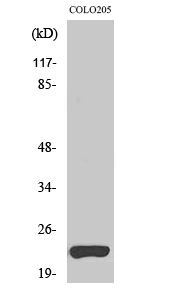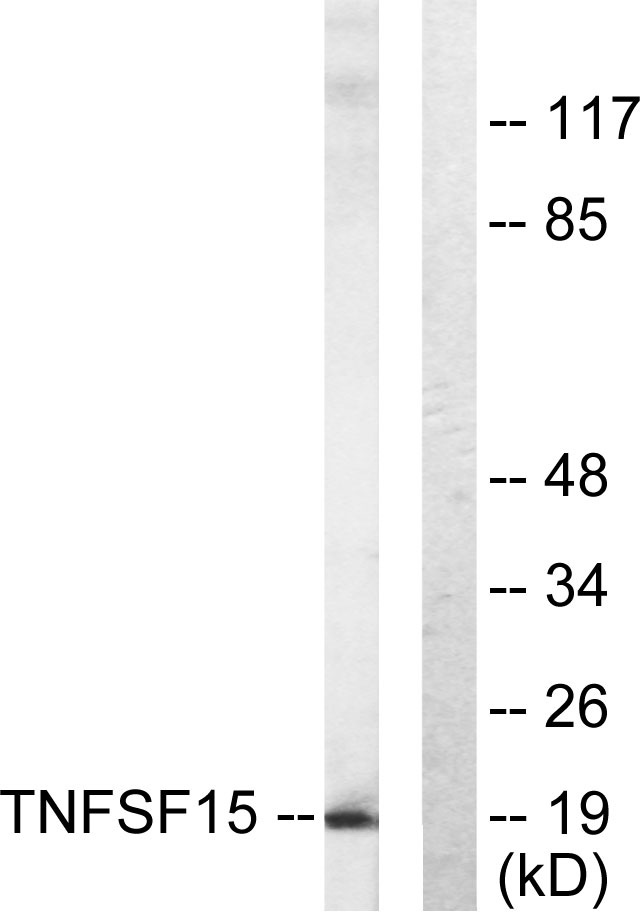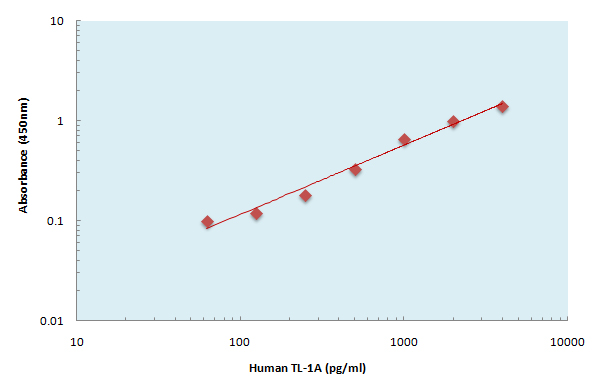VEGI Polyclonal Antibody
- Catalog No.:YT4873
- Applications:WB;IF;ELISA
- Reactivity:Human;Rat;Mouse;
- Target:
- VEGI
- Fields:
- >>Cytokine-cytokine receptor interaction
- Gene Name:
- TNFSF15
- Protein Name:
- Tumor necrosis factor ligand superfamily member 15
- Human Gene Id:
- 9966
- Human Swiss Prot No:
- O95150
- Mouse Swiss Prot No:
- Q5UBV8
- Immunogen:
- The antiserum was produced against synthesized peptide derived from human TNFSF15. AA range:181-230
- Specificity:
- VEGI Polyclonal Antibody detects endogenous levels of VEGI protein.
- Formulation:
- Liquid in PBS containing 50% glycerol, 0.5% BSA and 0.02% sodium azide.
- Source:
- Polyclonal, Rabbit,IgG
- Dilution:
- WB 1:500 - 1:2000. IF 1:200 - 1:1000. ELISA: 1:20000. Not yet tested in other applications.
- Purification:
- The antibody was affinity-purified from rabbit antiserum by affinity-chromatography using epitope-specific immunogen.
- Concentration:
- 1 mg/ml
- Storage Stability:
- -15°C to -25°C/1 year(Do not lower than -25°C)
- Other Name:
- TNFSF15;TL1;VEGI;Tumor necrosis factor ligand superfamily member 15;TNF ligand-related molecule 1;Vascular endothelial cell growth inhibitor
- Observed Band(KD):
- 20kD
- Background:
- The protein encoded by this gene is a cytokine that belongs to the tumor necrosis factor (TNF) ligand family. This protein is abundantly expressed in endothelial cells, but is not expressed in either B or T cells. The expression of this protein is inducible by TNF and IL-1 alpha. This cytokine is a ligand for receptor TNFRSF25 and decoy receptor TNFRSF21/DR6. It can activate NF-kappaB and MAP kinases, and acts as an autocrine factor to induce apoptosis in endothelial cells. This cytokine is also found to inhibit endothelial cell proliferation, and thus may function as an angiogenesis inhibitor. Two transcript variants encoding different isoforms have been found for this gene. [provided by RefSeq, Feb 2011],
- Function:
- function:Receptor for TNFRSF25 and TNFRSF6B. Mediates activation of NF-kappa-B. Inhibits vascular endothelial growth and angiogenesis (in vitro). Promotes activation of caspases and apoptosis.,induction:Up-regulated by IL-1-alpha and TNF-alpha.,similarity:Belongs to the tumor necrosis factor family.,subunit:Homotrimer.,tissue specificity:Specifically expressed in endothelial cells. Detected in monocytes, placenta, lung, liver, kidney, skeletal muscle, pancreas, spleen, prostate, small intestine and colon.,
- Subcellular Location:
- Membrane ; Single-pass type II membrane protein .; [Tumor necrosis factor ligand superfamily member 15, secreted form]: Secreted.
- Expression:
- Specifically expressed in endothelial cells. Detected in monocytes, placenta, lung, liver, kidney, skeletal muscle, pancreas, spleen, prostate, small intestine and colon.
- June 19-2018
- WESTERN IMMUNOBLOTTING PROTOCOL
- June 19-2018
- IMMUNOHISTOCHEMISTRY-PARAFFIN PROTOCOL
- June 19-2018
- IMMUNOFLUORESCENCE PROTOCOL
- September 08-2020
- FLOW-CYTOMEYRT-PROTOCOL
- May 20-2022
- Cell-Based ELISA│解您多样本WB检测之困扰
- July 13-2018
- CELL-BASED-ELISA-PROTOCOL-FOR-ACETYL-PROTEIN
- July 13-2018
- CELL-BASED-ELISA-PROTOCOL-FOR-PHOSPHO-PROTEIN
- July 13-2018
- Antibody-FAQs
- Products Images

- Western Blot analysis of various cells using VEGI Polyclonal Antibody. Secondary antibody(catalog#:RS0002) was diluted at 1:20000

- Immunofluorescence analysis of HeLa cells, using TNFSF15 Antibody. The picture on the right is blocked with the synthesized peptide.

- Western blot analysis of lysates from COLO205 cells, using TNFSF15 Antibody. The lane on the right is blocked with the synthesized peptide.

